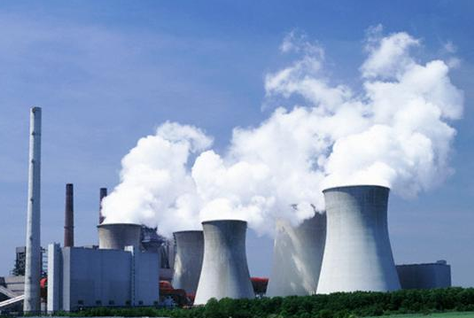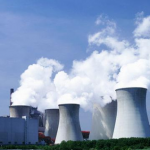Over the years countries all over the world are exploring for the alternate source of energy besides thermal and hydro power. Consequently, they have been successful also in the form of coming up with alternate source such as wind energy, tidal power and solar energy. But one important source of energy which we often neglected is Nuclear energy. Nuclear energy has long been used by the countries for the defence against their enemies but there has always been a debate for its use for the civil purpose regarding safety issues and all.
Nuclear power is the use of sustained exothermic nuclear processes to generate heat and electricity. The bonds that hold atoms together contain an enormous amount of energy in them. This energy can be released through the splitting of one atom into two or more lighter atoms which is known as nuclear fission or by the joining of two atoms which is referred as nuclear fusion.
When the nuclei of certain atoms absorb a free neutron energy is released, which become unstable and move apart, releasing one or more than one free neutrons. This process is replicated by producing an unfueled chain reaction. In case of commercial nuclear power plants, the heat which is generated is used to create steam which in turn, turns a turbine and generates electricity, without effecting the environment with any kind greenhouse gas emission.
A nuclear power plant as mentioned in the above paragraph is a thermal power station in which the heat source is a nuclear reactor which is used to initiate and control a sustained nuclear chain reaction. As is typical in all conventional thermal power stations the heat is used to generate steam which drives a steam turbine connected to a generator which produces electricity.
As far as the history of nuclear energy is concerned it was Ancient Greek philosophers who first developed the idea that all matter is made of atoms. From the 18th and 19th centuries onwards we see scientists were conducting experiments bringing out details about ATOMS.
Albert Einstein developed his theory of the relationship between mass and energy. In 1938, Lise Meitner and Otto Hahn provided the first experimental evidence of the release of energy from fission. Finally on 2 December 1942, world’s first self-sustained nuclear fission chain reaction occurred in a squash court under the University of Chicago’s Stagg Field.
Electricity Generation
Coming to the use of nuclear energy for civil and commercial purpose, the first civilian nuclear power plant began generating electricity at Santa Susana, California on July 12, 1957. On the other hand first large-scale commercial nuclear power plant in the U.S. began functioning on December 2, 1957, in Shipping port, Pennsylvania and continued to operate until it was shut down in 1982.
The contribution of Nuclear Power stations, excluding that of naval nuclear reactors, is about 5.7% of the world’s energy and 13% of the world’s electricity, in 2012. According to IAEA in 2013, there were 437 operational nuclear power reactors however not all are producing electricity in 31 countries.

In 2011 nuclear power provided 10% of the world’s electricity. Among the nuclear energy producing countries United States produces the most nuclear energy, with nuclear power providing 19%of the electricity it uses, while France generates the highest percentage of its electrical energy from nuclear reactors—80% as of 2006. France derives over 75% of its electricity from nuclear energy. In 2011 French electricity generation was 542 billion kWh net, and consumption was 478 billion kWh (down from 513 billion kWh in 2010 due to being a mild year) – about 6800 kWh per person.
This huge generation of electricity through Nuclear energy is of great help to the automation industry which depends on the electricity for its working. Power failure, environmental concerns and shortage of fossil fuels, etc are some of the bottlenecks which often slow down the growth of the automation industry. However, with the use of Nuclear Energy, future looks promising.
Commercial Use of Nuclear Energy
The world’s first commercial nuclear power station was opened in 1956, named Calder Hall at Windscale, England, with an initial capacity of 50 MW (later 200 MW). In United States the first commercial nuclear generator to become operational was the Shipping port Reactor (Pennsylvania, December 1957). Today there are about 430 commercial nuclear power reactors operating across 30+ nations, with a total capacity of 372,000 MWe.
These power plants provide about 13.5% of the world’s electricity as uninterrupted, authentic base-load power, with increased efficiency. Moreover, 56 countries operate a total of about 240 research reactors and a further 180 nuclear reactors power some 150 ships and submarines.
Nuclear energy is a blessing for the automation industry and we find that many automation industries are looking up to it. One such industry is Hollysys Automation Technologies which has recently announced that its proprietary HOLLiAS-N Distributed Control System (“HOLLiAS-N DCS”) was successfully applied to Unit 1of Ningde Nuclear Power Plant (“Ningde NPP”) and went into commercial operation. Hollysys Automation Technologies, Ltd. (NASDAQ: HOLI) is a China based company which is a leading provider of automation and control technologies and applications.
Nuclear energy is the lowest-cost producer of base-load electricity. In the last 10 years average nuclear production costs have declined more than 30 percent, to an average of 2.0 cents per kilowatt-hour. This includes the costs goes in operating and maintaining the plant, purchase of nuclear fuel, and paying for the management of used fuel.
On the other hand compared to fossil fuel and renewable energy sources, electricity generated through nuclear energy has tremendous price stability because only 28 percent of production costs are fuel costs. In power plants where electricity is generated through fossil-fuel, of the total cost of electricity production 80 -90 percent is taken by the fuel accounts. Moreover, low and stable cost of nuclear power helps reduce the price of electricity paid by consumers. One more advantage of nuclear energy is that it does not create any greenhouse gas.
However there certain issues regarding the use of Nuclear energy that needs to be discussed. The first issue is regarding the cost, it is a very huge investment. Then there are environmental concerns such as accidents at nuclear plants and reactors, ranging from a major disaster of a reactor core to minor accidents that release relatively small amounts of radioactivity into the environment. Disposal of highly radioactive waste is another important concern raised by the critics of the use of nuclear energy.
Nuclear energy has the potential to solve many problems such as shortage of power, fossil-fuels and its impact on the environment. However, it has to be done keeping in mind the safety and security of the plant as well the impact it can have on the surrounding.

